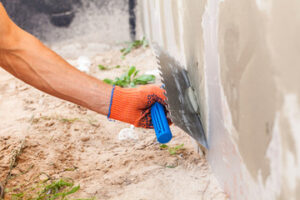If your home has a cracked foundation, leaky plumbing, or sticky doors, it’s time to repair it. specialists have the tools, equipment, and knowledge that are focused explicitly on repairing foundations.

They understand how each repair method impacts the soil composition beneath your home and can suggest the best option for your needs. They also know this is a job you only want to do once.
Steel piers are ideal for foundation repair when they can reach the load bearing stratum below the house. To determine if this stratum can be reached, expert evaluators review the soil map and perform a soil test at your property.
These piers are driven deep into the ground and transfer the weight of your structure from the unstable soil to the bedrock below. They are an excellent solution for sinking foundations that can be caused by a variety of circumstances, including the loss of soil moisture and the presence of hydrostatic pressure.
Because they do not rely on skin friction to support the structure, these piers are very stable and offer a long-term solution. In addition, they can be installed quickly and have a high capacity. They are also less susceptible to soil movement than other types of piers.
Another advantage of steel piers is that they require minimal maintenance, which can save homeowners time and money. However, they can be more expensive than other pier options, making it important for home and business owners to weigh the cost vs. longevity of these piers before selecting one for their foundation repair.
A downside of steel piers is that they can be damaged by chemical exposure. If left untreated, the acidity in rain and minerals in the soil can corrode and weaken them, compromising their structural integrity. These piers can be protected against this by having them galvanized, which adds a protective molten zinc coating to the surface of the piers.
For home and business owners looking for a long-term solution to their foundation problem, steel push piers are the best option. These piers are pre-engineered to transfer the load from your foundation to the stable bedrock below. They are installed using a two-stage process that involves driving the precision-manufactured piers through the weak soil and down to the bedrock, then lifting your foundation to restore its original elevation. Each pier is load tested during the installation process to ensure that it can safely carry the load of your structure. The piers are placed at a rate of four per day, and the excavation site is filled back in and compacted after each placement.
Concrete Pile
In the world of civil engineering, concrete piles provide a deep foundation that can support colossal structures like skyscrapers and bridges. Long and slender, these concrete segments are driven down into the earth to reach layers that have the strength needed to hold massive loads. Like any construction method, however, concrete piles have their pros and cons.
For instance, one of the big issues with pressed piles is their longevity. Because they are pushed into the ground, these pilings are subject to constant tension. Over time, this can cause damage to the surface of the pile and lead to premature failure. However, these concerns can be mitigated by using advanced technology to monitor pile performance.
In addition, new techniques have been developed that reduce the amount of energy used to drive a pile into the ground. This, in turn, helps to reduce the environmental impact of these projects. For example, the use of sensors and digital monitoring systems allow for real-time analysis of conditions around a pile and its structural integrity.
While this isn’t a perfect solution, it is an important step in minimizing the impact of construction on our environment. In the future, this technology will likely be used to improve the efficiency of pile installation methods as well.
Another benefit of concrete piers is that they are easy to repair if damage occurs. For this reason, they are an excellent choice for situations or homeowners that don’t care about longevity or want a faster turnaround time than other options.
The process of repairing a pressed pile involves removing the damaged section and replacing it with a new piece. This can be done in the field or offsite. Then, the pile is reinstalled and tested. In some cases, the pile may need to be repositioned slightly to ensure proper alignment with the existing foundation of the home.
Another way to repair a sagging or sinking pile is to install a concrete helical anchor. This is a simple but effective solution for lifting your foundation without the need for excavation. This type of repair is usually completed in just a few days.
Poured Concrete Piers
A concrete pier is a solid cylinder of reinforced poured concrete. These piers have a wide base hidden below the surface of the ground that they rest on. When these piers go out of plumb (which is quite often in expansive clay soils) they can cause serious damage to the structure of your home or business. Typically, this type of damage will lead to cracks in walls and floors. It may also affect doors and windows, as well as the stability of the roof.
If your pier and beam foundation is experiencing issues, you should be able to tell by the appearance of your home and by the difficulty in opening or closing doors and windows. It is important to take action promptly, as these signs are usually indicators of an underlying problem with your foundation. If you’re unsure whether or not your foundation is exhibiting these symptoms, it’s best to contact an expert for advice.
To repair a building using a poured concrete pier, crews drill several cylindrical holes below the foundation up to a suitable depth. Liquid concrete is then poured into the holes, and after the concrete has cured, crews lift the building with hydraulic bottle jacks. They then shim the foundation with steel shims to level it.
While this is a relatively inexpensive and fairly reliable method of foundation repair, the concrete piers are not as strong as steel piers and can sink over time in poor soil conditions. They are also less resistant to water pressure. If you are considering a poured concrete pier for your foundation repair, be sure to talk to the contractor about installing a drainage system to keep your foundation dry.
Like anything, a pier and beam foundation will eventually wear out and require repair or replacement. Fortunately, routine maintenance and inspections can help to extend the life of your pier and beam foundation. If you do notice damage to your pier and beam foundation, you should seek the assistance of a professional immediately. A quick fix can prevent future problems and prevent the need for costly repairs.
Helical Piers
The helical pier system is an alternative to traditional foundation repair methods, and it can be installed at any time during the structural stabilization process. It’s less invasive, and it doesn’t require the use of heavy machinery or concrete pouring. It also requires significantly less excavation, and it leaves a smaller footprint on your yard and lawn.
During the installation process, foundation experts evaluate your home’s soil conditions and structure. They mark the location for each helical pier based on the load requirements and ground conditions. Then, a hydraulic machine is used to screw the piers into the ground until they reach the required torque or depth. Once the piers are in place, they are connected to the foundation with steel brackets. The weight of your foundation is then transferred to the helical piers, restoring its stability and strength.
Each helical pier consists of a central pin with helix-shaped plates welded on it. The diameter of these plates will vary according to the soil type – rocky soils call for smaller ones, while loose or sandy soils demand larger ones. The helix-shaped plates on the piers are then wrapped with a polyethylene green sleeve to safeguard against any ground movement.
When it comes to underpinning foundations, helical piers are often more effective than traditional foundation piers because they can transfer structural loads immediately after being installed. They can also be installed in places where there isn’t much space to dig a conventional foundation footing, such as in tight corners and small backyards.
These piers are a preferred solution for underpinning basement walls and other foundations that are sinking or shifting. They are especially useful when a building is undergoing extensive settlement, as they can lift the foundation back to its original base level.
A damaged or weakened foundation can cause a lot of problems in your home, and it’s important to address these issues as soon as possible. If you notice the signs of a compromised foundation, contact us to schedule an inspection and evaluation. Delaying this important work can result in additional damage and escalating costs down the road.
